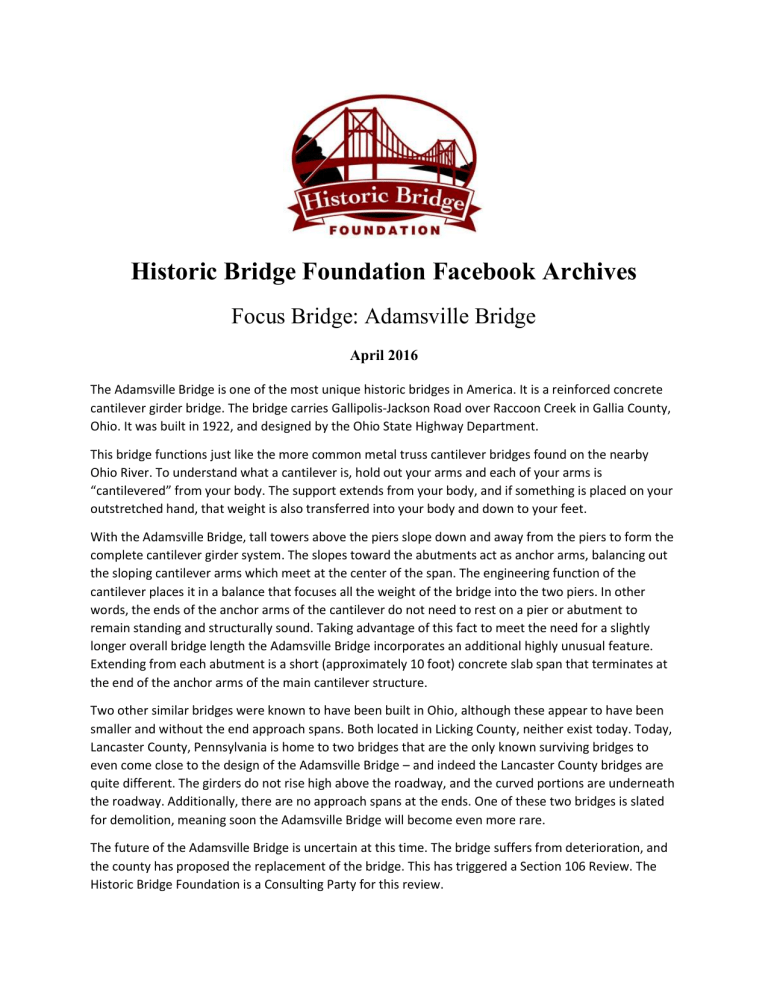
Historic Bridge Foundation Facebook Archives Focus Bridge: Adamsville Bridge April 2016 The Adamsville Bridge is one of the most unique historic bridges in America. It is a reinforced concrete cantilever girder bridge. The bridge carries Gallipolis-Jackson Road over Raccoon Creek in Gallia County, Ohio. It was built in 1922, and designed by the Ohio State Highway Department. This bridge functions just like the more common metal truss cantilever bridges found on the nearby Ohio River. To understand what a cantilever is, hold out your arms and each of your arms is “cantilevered” from your body. The support extends from your body, and if something is placed on your outstretched hand, that weight is also transferred into your body and down to your feet. With the Adamsville Bridge, tall towers above the piers slope down and away from the piers to form the complete cantilever girder system. The slopes toward the abutments act as anchor arms, balancing out the sloping cantilever arms which meet at the center of the span. The engineering function of the cantilever places it in a balance that focuses all the weight of the bridge into the two piers. In other words, the ends of the anchor arms of the cantilever do not need to rest on a pier or abutment to remain standing and structurally sound. Taking advantage of this fact to meet the need for a slightly longer overall bridge length the Adamsville Bridge incorporates an additional highly unusual feature. Extending from each abutment is a short (approximately 10 foot) concrete slab span that terminates at the end of the anchor arms of the main cantilever structure. Two other similar bridges were known to have been built in Ohio, although these appear to have been smaller and without the end approach spans. Both located in Licking County, neither exist today. Today, Lancaster County, Pennsylvania is home to two bridges that are the only known surviving bridges to even come close to the design of the Adamsville Bridge – and indeed the Lancaster County bridges are quite different. The girders do not rise high above the roadway, and the curved portions are underneath the roadway. Additionally, there are no approach spans at the ends. One of these two bridges is slated for demolition, meaning soon the Adamsville Bridge will become even more rare. The future of the Adamsville Bridge is uncertain at this time. The bridge suffers from deterioration, and the county has proposed the replacement of the bridge. This has triggered a Section 106 Review. The Historic Bridge Foundation is a Consulting Party for this review. This clipping from the original design drawings shows the arrangement of the internal reinforcement (rebar) for the bridge. Notice how the rebar radiates out from the “tower” of the bridge at an angle. This is similar to the diagonal members found on many steel cantilever truss bridges, and is evidence of the cantilever function of the concrete girders of the bridge. Appearing in a 1923 Engineering News-Record Article was this photo of a concrete cantilever bridge in Licking County, Ohio. It was one of two built in that county. Both no longer exist today. Lancaster County, Pennsylvania is home to two bridges that are the only known surviving bridges to even come close to the design of the Adamsville Bridge. This is the Farmersville Road Bridge, and it is slated for demolition and replacement. It was built in 1917. Lancaster County, Pennsylvania is home to two bridges that are the only known surviving bridges to even come close to the design of the Adamsville Bridge This is the Lime Valley Road Bridge, built in 1927. The Winona Bridge over the Mississippi River in Minnesota is a traditional example of a steel cantilever through truss. Compare to the Adamsville Bridge: note the similar shape of the truss, with two tall towers at the pier points.



